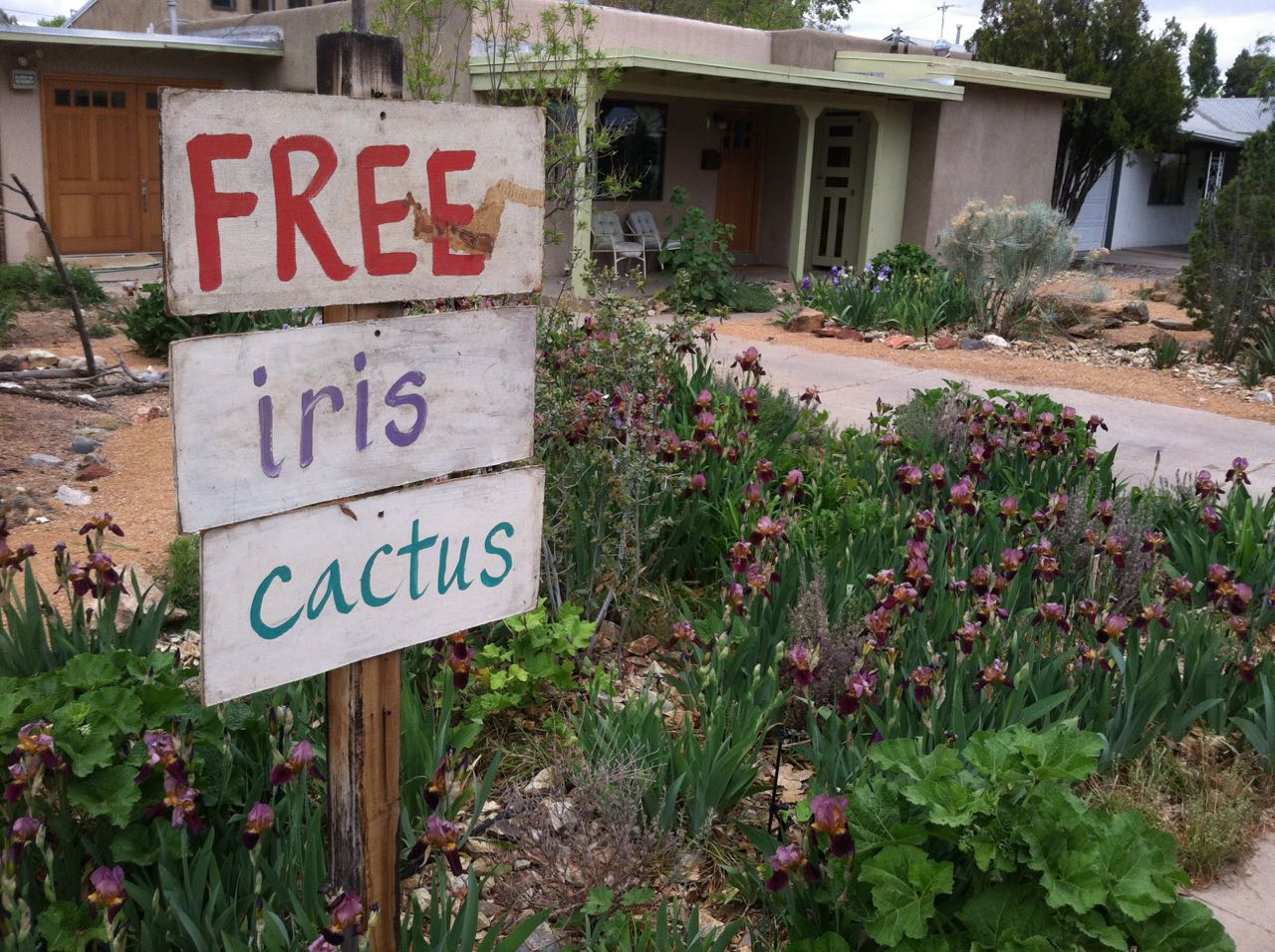It was free iris (and a little cactus) day today at the Lissa Heineman Garden and Art Emporium.
The garden, a project of 20-plus years’ duration, has come to be Lissa’s best work of art (at least that’s what I think), a constantly evolving thing that is great in part because it will never be done. The purple iris (and maybe a few brown ones you can’t see here) are the only remnants of the landscaping we inherited when we bought the house in 1993. They started as a clump of maybe a dozen, living off to the left of this picture where the cholla and some other cacti dominate a mound. Lissa’s been separating and spreading the iris out for years, and culling extras that she puts in bags on the sidewalk. Their offspring are all over the neighborhood now.
The color is wonderful at bloom time, but it shifts through the seasons and is always lovely. Like the rules that constrain a haiku, our attitudes toward water use place boundaries that influence its direction, and the color palette of the desert is an integral part of the piece – both the desert colors of the soil and cactus, and the counterpoints of the small wetter bits that Lissa arranges within it.
It’s sculptural, with the great forms of three piñon of varying sizes and the wonderful mass of the cactus, but a tendentious physicality – more within Lissa’s influence than control, which is part of what makes watching her relationship with this particular piece of art so enchanting.
Free iris today was fun, with neighbors and visitors to a garage sale across the street grabbing them up as fast as I could bag up Lissa’s culls and put them out on the sidewalk. The audience loves this work of art, and the bags give them a chance to join in.


I thought Johnny Appleseed actually mostly was planting apples that weren’t very good for eating, because the ones that are good for eating are hybrids and they tend to revert back, so they were used for cider apples, and people loved him because they were drunk. That could be an urban legend, but if it is true, then she’s doing irises in a DIFFERENT style because she is clearly doing this from bulbs, not seeds, and also people like them because they are pretty, as opposed to because they enjoy alcohol.
I’m scared to look that story up because it is probably a lie
You are correct, though important similarities remain – our neighbors (I hope) also are not eating that, and are surely drunk with the flowers’ beauty.
Ma here has gone wild over the years with flowers and decorations (her style is very whimsicle) and we’ve covered large areas with crushed limestone because we don’t want to mow grass. now all but a little is left as grass, the rest is gardens or decorations. so if Lissa or you might want to visit and look at the pictures they are at:
http://www.anthive.com/flowers.htm
(a few others under other sections from the main
page too)l
the pictures are mine, but the camera is now broken and not yet replaced so not many updates recently.
you should see the before and after pictures from years ago that i’ve not scanned/posted. going on 20yrs now.
oh, and i forgot to mention about apples. they are very complicated genetically and easily cross with others so that they rarely breed true from seeds, but you can still plant the seeds and get sour apples which are what was used for making cider in the old days. hard cider. once in a while you will discover in all those seedlings one with excellent taste, that is how many of the varieties that already exist have come about. someone finds a good one that has made it from seed and then it gets grafted like crazy and spread around to the orchards.
i sprouted a bunch of apple seeds last year and they’ve done well and survived. this fall i move the saplings to a new location and within four to six years i should have the beginning of a crop. won’t know until then if any of them will be good or if they will be critter and cider food, but what this will do is get a natural apple tree pest and pest feeder cycle going so that if i get some grafted trees and plant them in the same area then there will be an existing system to keep the pests under control. or at least that is the theory. 🙂